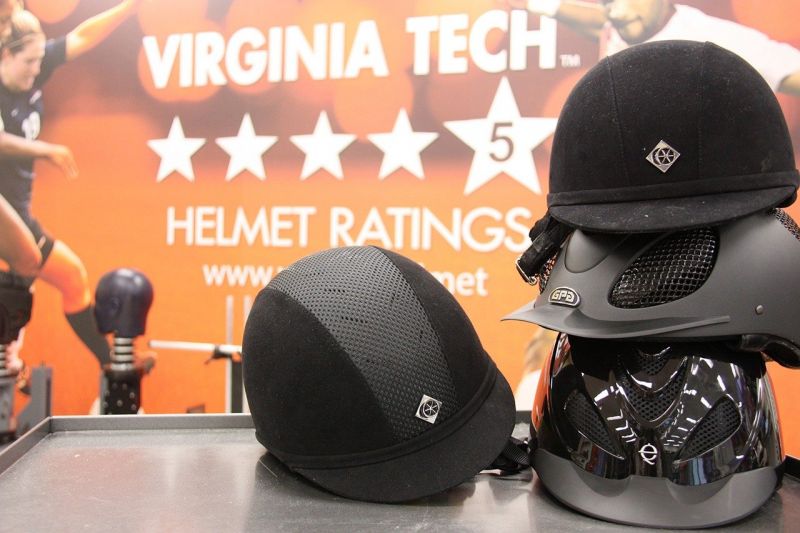
Since the Virginia Tech Helmet Lab launched in 2011, their staff has fielded a steady stream of calls from players and parents who need to buy a helmet and want to know which models are most effective. Some of those calls are about traditional contact sports — football, hockey. But a lot of them are about a topic you might not expect.
“Since we started the Helmet Lab, I’ve gotten more phone calls about equestrian helmets than I have about any other sport except football,” said Stefan Duma, who founded the lab and today directs the Institute for Critical Technology and Applied Science.
“So we know there’s interest. And when you look at the injury numbers, they are staggering.”
Current estimates put the annual U.S. tally of injuries associated with equestrian sports around 50,000; head impacts account for the largest portion of that total.
Duma, the Harry Wyatt Professor of Engineering, explains that the basic physics of riding a horse ratchet up the risk of head injury.
“When you’re on a horse, that puts your head about 8 to 10 feet off the ground. If you come off the horse for any reason, whether you’re thrown or you just fall, you end up with a much higher impact injury than people might expect,” he said.
The Helmet Lab is currently raising money through Virginia Tech’s JUMP crowdfunding platform to fund testing for the gear designed to protect riders from those impacts.
Most serious riders wear specialized equestrian helmets. But as for many sports, equestrian helmets are certified through a simple standard pegged to a very high impact-energy — the kind associated with catastrophic, and potentially life-threatening, head injuries. The pass-fail standard doesn’t provide consumers with any information about a helmet’s ability to protect a rider against milder — but still serious — injuries like concussion, and it doesn’t distinguish between a helmet that passes with flying colors and one that barely squeaks by.
Two helmets can pass the same standard and perform very differently, and consumers currently have no way of knowing that information.
“There is tremendous room for improvement not only in how helmets are evaluated, but also in utilizing advanced helmet technology,” Duma said.
That’s where the Helmet Lab comes in. Customized pendulums, drop towers, and other equipment recreate impacts experienced by athletes in a variety of sports — so far football, hockey, soccer, and cycling, with others in the pipeline. These sophisticated devices allow the lab’s researchers to test helmets and other protective headgear under realistic conditions, evaluating which models are most effective at managing the impact energy responsible for concussions and other head injuries.
The most visible outcome of this research has been the lab’s five-star helmet-rating system. The Virginia Tech Helmet Ratings have given consumers an independent, evidence-based tool to guide purchasing decisions; they’ve also driven innovation in the helmet industry by providing a more granular metric for evaluating different models against each other using test methods that are reproducible in the lab and relevant on the field.
Now, the group hopes to extend this model to equestrian helmets. They’ve already conducted preliminary tests, measuring the performance of six different helmet models with respect to the existing standard. All six helmets passed, but the results revealed wide variation in performance and significant room for improvement: the best equestrian helmet was still far less effective at managing impact energy than top-performing football helmets subjected to the same test. The researchers presented the data at the World Congress on Biomechanics in Dublin, Ireland, in 2018.
The next step is to extend the testing, running additional trials and developing the same kind of bespoke testing protocols and equipment that they have for other sports. The crowdfunding campaign will help cover the purchase of helmets and defray the cost of testing.
This is the helmet lab’s second foray into crowdfunding. In a previous project, 84 donors pitched in to raise $10,000 toward the purchase of padded headbands marketed to soccer players. The result was the first independent ratings ever published for soccer headgear, which gave consumers a new source of information and, incidentally, helped raise awareness about how effective this type of headgear can be.
Now, the Helmet Lab and their donors have another opportunity to make a difference for athletes.
“Equestrian sports have an unusually high risk of head injury, and I don’t think that’s widely recognized. Per exposure, there’s a higher risk of head injury than playing football or hockey or racing cars,” Duma said. “That, to me, is the big story — and that there’s so much room for improvement.”
–Virginia Tech




